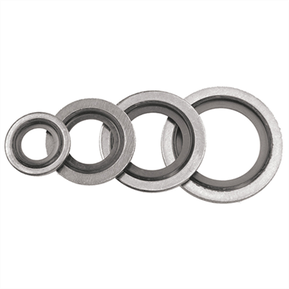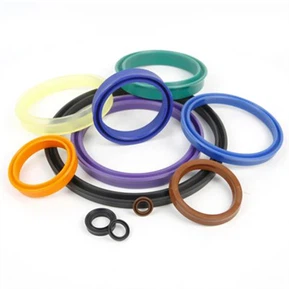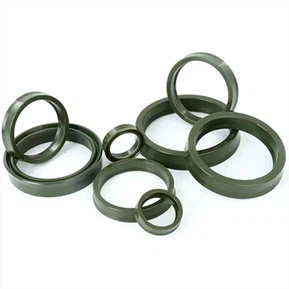What Is a Bonded Seal?
A bonded seal (also called a “bonded washer seal” or “combination seal”) is a dual-material sealing component designed to create a leak-proof barrier in threaded or flanged connections. Unlike an O-ring (which is a single elastic ring), a bonded seal combines two parts:
- A rigid metal outer ring (e.g., steel, stainless steel) that provides structural support and controls compression.
- An elastic elastomeric inner layer (e.g., rubber, silicone) that conforms to gaps and forms the actual seal.
These two parts are “bonded” together (via adhesives or molding) into a single, easy-to-install component. Its primary role is to prevent leakage of fluids (oil, fuel, water) or gases (oxygen, compressed air) in high-pressure, high-vibration, or threaded connections—where O-rings alone may fail due to extrusion (being pushed out of gaps) or uneven compression.
1. Core Structure & Working Principle
To understand how bonded seals work, let’s break down their design and functionality:
a. Structure Details
|
Component
|
Material Example
|
Purpose
|
|
Metal Outer Ring
|
Stainless steel, carbon steel, aluminum
|
– Maintains shape under high pressure/torque.- Prevents the elastomer from being “extruded” (squeezed out) of gaps between mating parts.- Distributes clamping force evenly across the seal.
|
|
Elastomeric Inner Layer
|
Silicone, NBR (nitrile rubber), FKM (fluororubber)
|
– Deforms to fill micro-gaps between threaded/flanged components.- Creates a flexible, leak-proof barrier against fluids/gases.- Resists chemical degradation from the medium (e.g., oxygen, oil).
|
b. How It Seals
When installed (e.g., between a bolted flange or a threaded fitting):
- The metal outer ring aligns the seal and limits how much the elastomer can compress (preventing over-deformation).
- As the connection is tightened (e.g., with a bolt), the elastomeric layer is compressed between the metal ring and the mating surfaces.
- The elastomer deforms to fill even irregular gaps (e.g., thread imperfections, surface roughness) that a rigid metal washer or a single O-ring couldn’t seal.
- The metal ring acts as a “shield,” stopping the elastomer from being pushed out of the gap (a common failure mode for O-rings in high-pressure threaded connections).
2. Key Materials for Bonded Seals
Material selection depends on the application’s pressure, temperature, and the fluid/gas being sealed. Below are common combinations, including options for oxygen systems (linking back to your prior interest):
|
Metal Ring Material
|
Elastomer Material
|
Key Properties
|
Typical Applications
|
|
Stainless Steel (304/316)
|
Silicone
|
Corrosion-resistant, oxygen-compatible, wide temperature range (-60°C to 230°C).
|
Oxygen tanks, medical gas fittings, food processing.
|
|
Carbon Steel
|
NBR (Nitrile Rubber)
|
Low cost, oil/fuel resistance.
|
Automotive engines (oil lines), hydraulic systems.
|
|
Aluminum
|
FKM (Fluororubber)
|
Lightweight, high-temperature resistance (up to 260°C), chemical resistance.
|
Aerospace (fuel lines), industrial ovens.
|
Critical for oxygen equipment: Bonded seals used in oxygen systems (e.g., high-pressure oxygen tank valves, POC pressure regulators) require stainless steel outer rings (to avoid corrosion) and silicone/FKM inner layers (to prevent reaction with oxygen, which could cause ignition). Oil-based elastomers (e.g., some NBR grades) are strictly avoided here.
3. Applications: When to Use Bonded Seals (vs. O-Rings)
Bonded seals excel in scenarios where O-rings are less reliable—especially in threaded connections or high-pressure systems. Below are key use cases, including overlaps with oxygen-related devices:
a. Oxygen & Medical Gas Systems
- Oxygen Tank Valves: Threaded connections on high-pressure oxygen cylinders use bonded seals to prevent catastrophic leaks. The metal ring resists the extreme pressure (up to 3,000 psi in medical tanks), while the silicone elastomer ensures a tight seal.
- POC Pressure Regulators: Bonded seals seal the connection between the POC’s compressor and pressure regulator, preventing oxygen leakage and maintaining consistent flow rates.
b. High-Pressure Industrial Systems
- Hydraulic/Pneumatic Lines: Threaded fittings in hydraulic machinery (e.g., construction equipment) use bonded seals to withstand pressures up to 10,000 psi—O-rings here would be extruded out of gaps.
- Chemical Processing: Bonded seals with FKM elastomers seal pipes carrying corrosive chemicals (e.g., acids), as the metal ring protects the elastomer from chemical attack.
c. Automotive & Aerospace
- Engine Oil Lines: Threaded oil fittings in car engines use bonded seals to resist vibration and high temperatures, preventing oil leaks that could damage the engine.
- Aerospace Fuel Systems: Bonded seals with aluminum rings and FKM elastomers are used in jet fuel lines, as they are lightweight and resist fuel degradation.
d. Plumbing & Heavy Machinery
- Water Pumps: Flanged connections in industrial water pumps use bonded seals to seal against high water pressure and prevent rust (via stainless steel rings).
4. Advantages Over O-Rings & Other Seals
Bonded seals solve key limitations of O-rings and traditional washers:
- Resists Extrusion: The metal ring stops the elastomer from being squeezed out of gaps in high-pressure or wide-gap connections (a major O-ring failure mode).
- Easy Installation: Unlike O-rings (which can slip out of place during assembly), bonded seals are a single component that stays aligned with threaded fittings.
- Uniform Sealing: The metal ring distributes clamping force evenly, ensuring the elastomer compresses consistently—even on rough or uneven surfaces.
- Durability: The metal outer ring protects the elastomer from physical damage (e.g., scratches from bolts) and extends the seal’s lifespan.
5. Maintenance & Replacement
Like O-rings, bonded seals are wearable components and need replacement over time. Signs of failure include:
- Leakage: Hissing (in gas systems) or visible fluid stains around the connection.
- Elastomer Damage: Cracking, hardening, or swelling of the inner elastomeric layer (from aging or chemical exposure).
- Metal Ring Damage: Rust, bending, or deformation (which breaks the bond with the elastomer).
Replacement guidelines:
- Always match the new seal’s material to the original (e.g., silicone elastomer for oxygen systems).
- Ensure the metal ring’s size fits the bolt/fitting (misalignment causes leaks).
- Avoid over-tightening: Excessive torque can damage the elastomer or metal ring.
6. O-Ring vs. Bonded Seal: Key Differences
To summarize how bonded seals compare to O-rings (your prior topic):
|
Feature
|
O-Ring
|
Bonded Seal
|
|
Structure
|
Single elastic ring
|
Dual-material (metal + elastomer) bonded component
|
|
Best For
|
Smooth, low-to-medium pressure gaps (e.g., POC sieve bed connections)
|
Threaded/high-pressure connections (e.g., oxygen tank valves, hydraulic lines)
|
|
Extrusion Resistance
|
Low (risk of being squeezed out in wide gaps)
|
High (metal ring prevents extrusion)
|
|
Installation
|
Prone to slipping out of place
|
Easy (single component, self-aligned)
|
Conclusion
Bonded seals are specialized sealing components that combine the flexibility of elastomers (like O-rings) with the structural strength of metal. They are critical for high-pressure, threaded, or vibration-prone systems—including oxygen tanks and POC regulators—where O-rings alone can’t reliably prevent leaks. By choosing the right material combination and maintaining them properly, bonded seals ensure long-term safety and efficiency in demanding applications.




